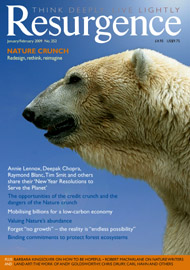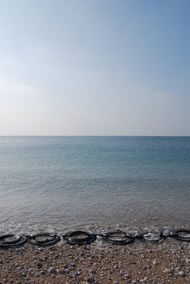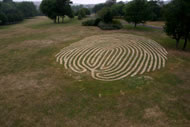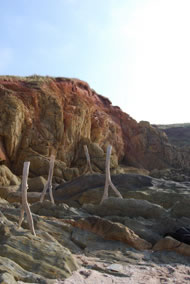SINCE PICASSO MADE a bull’s head from bicycle handlebars and saddle there has been a tradition of art made with recycled things. This could be seen to have its origins in the Surrealist movement, changing the context of familiar objects and re-assembling them into new forms which make us see them anew. Nowadays in the West we are peripheral recyclers and the producers and depositors of mountains of waste. Much of it is buried or burnt or discarded into the sea. Contemporary artists like David Kemp have reassembled the detritus from forest dumps and abandoned industrial waste into works that make a playful re-use of these materials but which confront us with our part in the throwaway society. In a comment on city life Tony Craggs has assembled a floor-based rainbow made from plastic litter: a poignant symbol of our casual contribution to the future.
Recently, Devon-based artist Carl Hahn has made sculptures that marry the use of discarded human-made materials with salvaged natural forms – often an uneasy alliance. He has been using car tyres to make temporary marks on the landscape. This has caused some upset. Most of us are guilty of adding to the tyre mountain. We have left a trail of rubber on roads and motorways, a speedy footprint but a long-lasting legacy of our motoring lives. Hahn has cut and woven tyres, giving them a strange beauty but engendering in the thoughtful viewer a real sense of unease. We are complicit. Hence the upset, mainly from those whose idea of beauty is disturbed by realism. The upset is that ‘alien’ material is not a proper medium for the artist. It rubs our noses in our own detritus.
HUMANKIND’S COMPULSION TO leave conscious marks on the surface of the world is age-old. The makers of the Nazca lines in Peru removed iron-oxide-coated pebbles which cover the surface of the desert to reveal the light-coloured earth beneath. These geometric, animal and human forms span nearly 200 square miles of desert and can be observed from the nearby foothills.
Contemporary land art emerged in the early 1970s as a movement that challenged the commercialisation of art. One of the most famous pieces is Robert Smithson’s Spiral Jetty (1970), in which rock, earth and algae were formed into a jetty protruding 1,500 feet into the Great Salt Lake in Utah. The work is visible only when the fluctuating water level falls.
Smithson’s work gave a context for the work of Richard Long, Chris Drury and Andy Goldsworthy, whose more ephemeral interventions with Nature and landscape are recorded by photographs and then allowed to ease their way back into the ground. The sensitively light touch with which each of these three approaches and leaves his work celebrates the Earth’s ability to leave little trace of their presence. It is as if a blackboard had been wiped clean. These artists walk lightly upon the skin of the Earth and their temporary interventions are reabsorbed.
The wide distribution and popularity of Goldsworthy’s books and documentaries have reawakened and inspired people to play creatively and make things in the landscape. In the last few years I have been surprised by the increasing numbers of stone lines, spirals and other marks people have left on beaches awaiting their redistribution by tidal forces. It is as if people are hungry for connections to the stuff of Nature and mindful of a need to play, to make and to create a modest art which needs no embarrassing public display, no evaluation. Its point is in the doing. It is in these places, too, that I have watched children pick plastic rubbish and add it innocently to their own decorated sandcastles alongside shells, seaweed and the increasingly rarer bits of driftwood. As adults we regard this artificial detritus as dirty rubbish. But we go on using it and producing it without much challenge to ourselves.
HAHN IS A restless and challenging character. He is a consummate and innovative craftsman. He has been a maker of sculptural furniture combining worn wood and found stone. Like other contemporary makers he has strayed delightedly into sculpture. He grasps the nettles of debate and concern that preoccupy both those in the art world and those immersed in ecological matters. What he makes now is not comfortable.
Hahn’s last project, called ‘Chinese Whispers’, was undertaken in collaboration with photographer Judy Carruthers. Carruthers began by sharing a treasured image and Hahn used it as a catalyst, developing an idea into a sculptural form and putting it into a landscape, whereupon Carruthers photographed it and ‘whispered’ her response. The ‘Whispers’ continued into a series of pieces temporarily placed, with elements of each recycled in the next, and so on. Thus they influenced each other and the series was documented by Carruthers.
Some of Hahn’s split-wood sculptures leap like Matisse’s wild dancers through the landscape. Clusters of sticks clamber uncomfortably over barbed-wire fences like an invading force, but it is the tyres that bring us to a halt. Unlike innocent children who can claim plastic beach treasures and still see them as jewels, Hahn makes us confront what we have discarded.
Whilst Richard Long, David Nash and many others have done us a great service in helping us to recognise the presence of Nature and the role of the weather, of the great elements and of the seasons, Hahn imbues his work with discomfort. One of the essential roles of an artist must surely be to challenge the way we see the world and to make visible the invisible or what we have grown too used to not seeing. Hahn’s work is not rooted in place, making a claim for structural longevity; it certainly does not just melt back into Nature. It is reassembled to challenge us about the way we live now. It may well be an unconscious connection but it seems to me that the tyres recall the roads we have cut brashly through our shrinking countryside. Will these be the ugly, unconsidered ‘Nazca’ lines of our speeding culture?
There is a role for the very material of artworks to be that which we thoughtlessly produce, use and carelessly discard. Through the hands of the artist our refuse can even be transformed into a curious beauty. But if we allow ourselves to stop, look, consider and think of the way that our own detritus contributes to mountains of waste, then art can make its contribution to challenge our inconsistencies.











